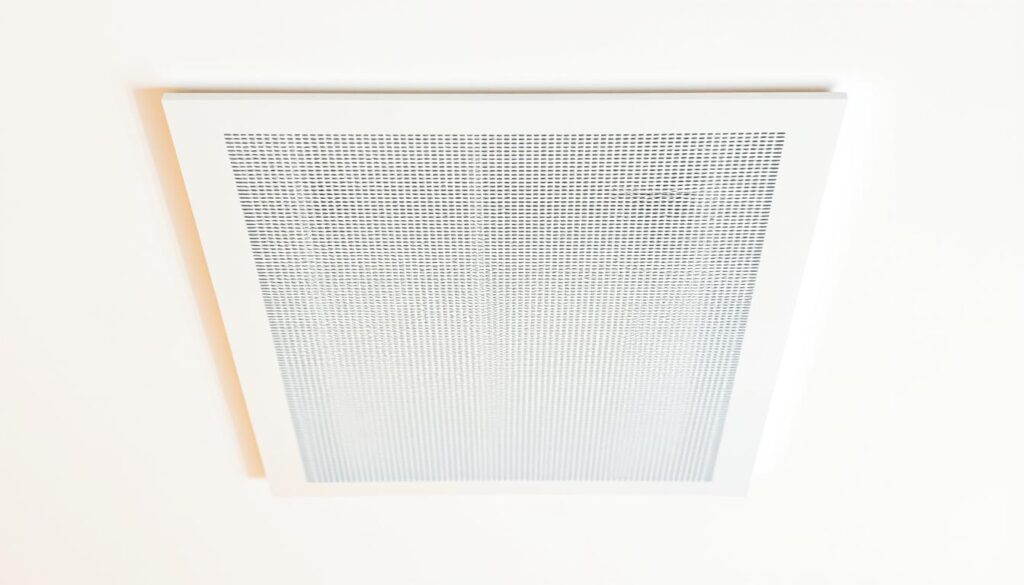Affiliate Disclosure
HVAC Guide Guys is a participant in the Amazon Services LLC Associates Program, an affiliate advertising program designed to provide a means for sites to earn advertising fees by advertising and linking to Amazon.
What Is A Diffuser In HVAC? Ever wondered how your indoor spaces stay perfectly cool and fresh? It’s all thanks to a key part of your HVAC system: the diffuser.

An HVAC diffuser is more than just a vent. It’s a smart device that changes how air moves in your space. Unlike regular vents, it controls air flow, speed, and spread for the best comfort.
Learning about HVAC diffusers shows the amazing tech behind keeping your space comfy. These devices make sure every part of your room gets even, comfortable air.
Key Takeaways
- HVAC diffusers control air distribution more precisely than standard vents
- They play a critical role in keeping room temperatures steady
- Diffusers also boost indoor air quality
- Different diffusers fit different room needs
- Choosing the right diffuser affects energy use and comfort
Understanding HVAC Diffuser Basics
HVAC diffusers are key in air systems for comfort and efficiency. They change how air moves in your space, making it perfect for temperature and airflow.
Looking into how diffusers work shows their smart design and importance. They keep the air in your space clean and fresh.
Key Components of an HVAC Diffuser
- Grille or face plate: Controls air direction and pattern
- Damper mechanism: Regulates airflow volume
- Mounting frame: Ensures secure installation
- Aerodynamic blades: Guide air distribution efficiently
Functional Dynamics in HVAC Systems
Air systems use diffusers to turn fast air into soft streams. Your comfort depends on how well these devices spread air.
“A well-designed diffuser is like an orchestra conductor, directing air with precision and grace.” – HVAC Engineering Insights
Strategic Air Distribution Principles
Diffusers are vital for even room temperatures and air flow. They work quietly, balancing comfort and saving energy in your space.
Knowing these basics helps you see the advanced engineering behind keeping your space comfy and healthy.
What Is A Diffuser In HVAC
A diffuser in HVAC is key to how air moves inside your home or office. These smart devices help control air flow, making your space comfortable and efficient.
A diffuser’s main job is to manage airflow from your HVAC system. There are different types, but they all aim to distribute air evenly across a room.
- Breaks up airflow into smaller streams
- Controls air velocity and direction
- Reduces drafts and temperature variations
- Improves overall indoor air comfort
Today’s HVAC diffusers do more than just distribute air. They can also reduce noise, mix air better, and even spread scents. They work quietly, keeping your space just right for you.
Table of Contents
Knowing how HVAC diffusers work shows their big role in indoor climates. They’re vital for keeping temperatures steady and air clean, whether at home or in a business.
Explore Our HVAC Shop
Looking for top-rated HVAC tools, parts, and accessories? Visit our shop and find the perfect solution for your needs.
Visit the ShopTypes of HVAC Diffusers
Knowing about different supply air diffuser types is key for good air flow in commercial and home settings. Each place needs a special diffuser to make air flow better, feel more comfortable, and save energy.
HVAC experts and building managers have many diffuser choices. Each has its own features and uses:
Ceiling Diffusers: The Standard Solution
Ceiling diffusers are the most used air distribution method. They come in square or round shapes and fit into ceiling grids. These diffusers spread air evenly and can be adjusted to change air flow direction.
- Square designs for standard room layouts
- Circular models for more flexible air pattern control
- Available in various sizes to match room dimensions
Linear and Slot Diffusers: Modern Architectural Approach
Linear and slot diffusers have a modern look for today’s spaces. They are made for precise air flow with little visual impact.
| Diffuser Type | Key Features | Best Application |
|---|---|---|
| Linear Diffusers | Long, narrow design | Open office spaces |
| Slot Diffusers | Minimal visual profile | High-end commercial settings |
Floor and Wall Diffusers: Flexible Placement Options
When you can’t put diffusers in the ceiling, floor and wall diffusers are good alternatives. They’re great for places with special design needs or architectural limits.
Selecting the right diffuser type depends on your specific spatial needs and HVAC system configuration.
Every diffuser type has its own benefits for air distribution. They help make spaces comfortable and efficient in many ways.
Benefits of Installing HVAC Diffusers
HVAC diffusers are key to making indoor spaces comfortable and healthy. They do more than just move air. They change how air systems work in homes and businesses.
Knowing the benefits of HVAC diffusers helps you choose better for your air quality and comfort:
- Enhanced Air Circulation: Diffusers get rid of temperature differences by spreading air evenly
- Improved Air Quality: Good air systems cut down on stale air and dust, allergens, and pollutants
- Energy Efficiency: Smart diffusers make HVAC systems work better, saving energy
- Comfort Optimization: Even air flow stops hot and cold spots, making spaces nicer
Using HVAC diffusers right can really boost your air system’s performance. These smart devices make sure every part of your space gets the air it needs. This makes your living or work area healthier and more comfy.
Experts say picking the right diffusers for your space is important. It helps get the most benefits and makes your indoor climate the best it can be.
Air Distribution Patterns and Flow Mechanics
Knowing about hvac airflow patterns is key to a comfy and efficient indoor space. Your HVAC system uses advanced air systems to control temperature, humidity, and air quality everywhere.
The science of air movement is complex. It shows how conditioned air moves and mixes in a room. HVAC systems are designed to control airflow for the best comfort and energy use.
Throw and Drop Patterns
Throw and drop patterns explain how air flows from a diffuser into a room. These patterns are vital for air system understanding:
- Horizontal throw shows air movement across room surfaces
- Vertical drop tells how fast air falls from the diffuser
- Angle of discharge affects air circulation
Velocity and Temperature Control
HVAC experts adjust air velocity and temperature for comfort. The right mix stops drafts and keeps room temperatures steady.
| Velocity Factor | Impact on Comfort |
|---|---|
| Low Velocity | Little air movement, might cause stagnation |
| Medium Velocity | Good air flow |
| High Velocity | Could cause drafts and discomfort |
Air Mixing Effectiveness
Good air mixing makes sure conditioned air blends well with room air. Proper diffuser design helps spread temperature evenly and avoids cold or hot spots.
By grasping these hvac airflow patterns, you can make your HVAC system work better. This leads to more comfortable indoor spaces.
Explore Our HVAC Shop
Looking for top-rated HVAC tools, parts, and accessories? Visit our shop and find the perfect solution for your needs.
Visit the ShopCommercial vs Residential Diffuser Applications

It’s important to know the difference between commercial and residential diffusers. Each type is designed for a specific setting. They help manage airflow and keep the space comfortable.
Commercial spaces need strong diffusers for big areas and complex air needs. These systems have:
- Larger ceiling diffusers with multi-directional airflow
- High-capacity air management capabilities
- Designed for open floor plans like offices and warehouses
Residential diffusers are more about looks and feel. Homeowners often choose:
- Smaller, more aesthetically pleasing diffusers
- Baseboard and wall-mounted options
- Quieter air distribution systems
The main difference is in what they do and how they look. Commercial environments focus on efficiency and covering the whole area. Home settings aim for comfort and matching the decor.
Choosing the right diffuser depends on your specific space and air circulation needs.
When picking a diffuser, think about function, energy use, and looks. This mix creates the best indoor space.
Installation Guidelines and Best Practices
Installing an HVAC diffuser needs careful planning and precision. The way you install it can greatly affect your heating and cooling system’s performance. A proper setup ensures the air is distributed well, keeping your indoor environment comfortable.
Before starting, consider several important factors that impact your diffuser’s performance.
Positioning and Placement
Choosing the right spot for your HVAC diffuser is key. Follow these guidelines:
- Measure room dimensions carefully
- Avoid placing near curtains or furniture
- Ensure even air distribution
- Keep away from direct sunlight or heat sources
Tools and Materials Required
Get ready with these tools for a successful installation:
- Measuring tape
- Drill
- Screwdriver
- Level
- Mounting hardware
Common Installation Mistakes to Avoid
Be careful of these common mistakes during installation:
- Improper sealing around the diffuser
- Incorrect angle alignment
- Neglecting manufacturer’s specific instructions
- Failing to check airflow direction
Pro Tip: While DIY installation is tempting, getting help from an HVAC expert can ensure the best results and avoid system issues.
Precision matters more than speed when installing HVAC diffusers.
Maintenance and Cleaning Requirements
Keeping your HVAC diffuser in good shape is key for the best air flow. Regular cleaning and checks help your diffusers work well. This keeps the air inside clean and your system running smoothly.
Your HVAC diffuser does more than just move air. It needs regular care to avoid dust and blockages. Here are important steps to keep your diffusers working great:
- Do visual checks every 3 months
- Clean diffusers every 3-6 months
- Look for dust buildup
- Make sure louvers move and are straight
Cleaning your HVAC diffuser is simple:
- Turn off the HVAC system
- Take out the diffuser carefully
- Use a soft cloth or vacuum with a brush
- Wipe with a mild soap solution
- Let it dry fully before putting it back
Warning: Don’t use harsh chemicals. They can harm the diffuser or lower system performance.
Experts say get a full check-up from a pro every year. This keeps your diffusers running at their best. It also helps your whole HVAC system last longer.
Explore Our HVAC Shop
Looking for top-rated HVAC tools, parts, and accessories? Visit our shop and find the perfect solution for your needs.
Visit the ShopTroubleshooting Common Diffuser Issues
HVAC systems need diffusers to work right for comfort. Knowing how to fix common problems helps keep your system running well.

Diffusers are key for air distribution in your space. Issues with them can hurt your system’s performance.
Addressing Airflow Problems
Airflow issues can come from many places in your HVAC system. Here are steps to troubleshoot:
- Look for things blocking air flow
- Check if diffusers are set up right
- Make sure air flows freely
- Check ducts for blockages
Resolving Noise Concerns
Strange noises from your diffuser might mean mechanical problems. Common noises include:
- Loose parts
- Blades not aligned
- Debris in the system
- Worn-out parts
Performance Issue Solutions
If your diffuser isn’t working right, try these steps:
| Symptom | Potential Cause | Recommended Action |
|---|---|---|
| Weak airflow | Clogged filters | Replace or clean filters |
| Uneven air distribution | Improper diffuser placement | Adjust positioning |
| Temperature inconsistencies | Blocked air paths | Clear obstruction paths |
Pro tip: Regular maintenance can prevent most diffuser performance issues. When in doubt, consult an HVAC professional for complex problems.
Selecting the Right Diffuser for Your Space
Choosing the right supply air diffuser types for your commercial HVAC diffusers is important. It affects comfort, air quality, and system performance.
- Room dimensions and ceiling height
- Airflow needs
- Design preferences
- Noise tolerance
- Budget
The right diffuser can change your space’s comfort and function. It should look good and work well.
Here are some tips to help you choose:
- Measure your space carefully
- Look at your HVAC system’s specs
- Get advice from experts
- Compare diffuser performance
Pro tip: Make sure the diffuser fits your HVAC system’s output. This ensures good air flow and energy use.
Selecting the right diffuser is not just about technical specs. It’s about making your indoor space perfect.
Commercial hvac diffusers come in many designs. You can choose from sleek lines to traditional squares. Pick one that fits your needs and decor.
Energy Efficiency and Cost Considerations
Understanding how HVAC diffusers work can really help your home feel better and save money. These systems are key to making your HVAC work better and use less energy.
Choosing the right HVAC diffuser is more than just moving air around. It affects how much energy your system uses and how much it costs to run. Good diffusers spread air evenly, which means your HVAC doesn’t have to work as hard.
- Reduce energy consumption by 10-15%
- Lower monthly utility bills
- Improve overall HVAC system performance
- Minimize temperature inconsistencies
When looking at energy efficiency, keep these points in mind:
| Factor | Impact on Efficiency | Potential Savings |
|---|---|---|
| Proper Diffuser Selection | Optimal Air Distribution | Up to 20% energy reduction |
| Regular Maintenance | Consistent Airflow | 5-10% energy savings |
| Advanced Diffuser Technology | Precise Air Control | 15-25% efficiency improvement |
High-quality diffusers might cost more at first, but they save money in the long run. Many energy-saving diffusers also get rebates from utilities, which can help you save even more.
“Smart diffuser selection is an investment in both comfort and energy conservation.”
By improving your air distribution systems, you can make your home more comfortable and save on energy bills.
Conclusion
Knowing what an HVAC diffuser is key to a comfortable home or office. These devices turn your heating and cooling system into a smart air distribution system. They do more than just control temperature; they shape comfort and efficiency in any space.
Choosing the right HVAC diffuser can greatly improve air quality and temperature control. Different types, like ceiling models for big spaces or wall units for homes, offer unique benefits. Learning about these systems can make a big difference in your indoor climate.
Today’s HVAC technology keeps getting better, making diffusers more advanced and energy-saving. When you think about your air distribution, remember that the right diffuser can improve air flow and save energy. Understanding these systems helps create healthier, more comfortable indoor spaces.
For homeowners or facility managers, choosing the right HVAC diffuser is a smart move. By following the tips in this guide, you can enhance your space’s air distribution. This leads to better comfort and efficiency.

